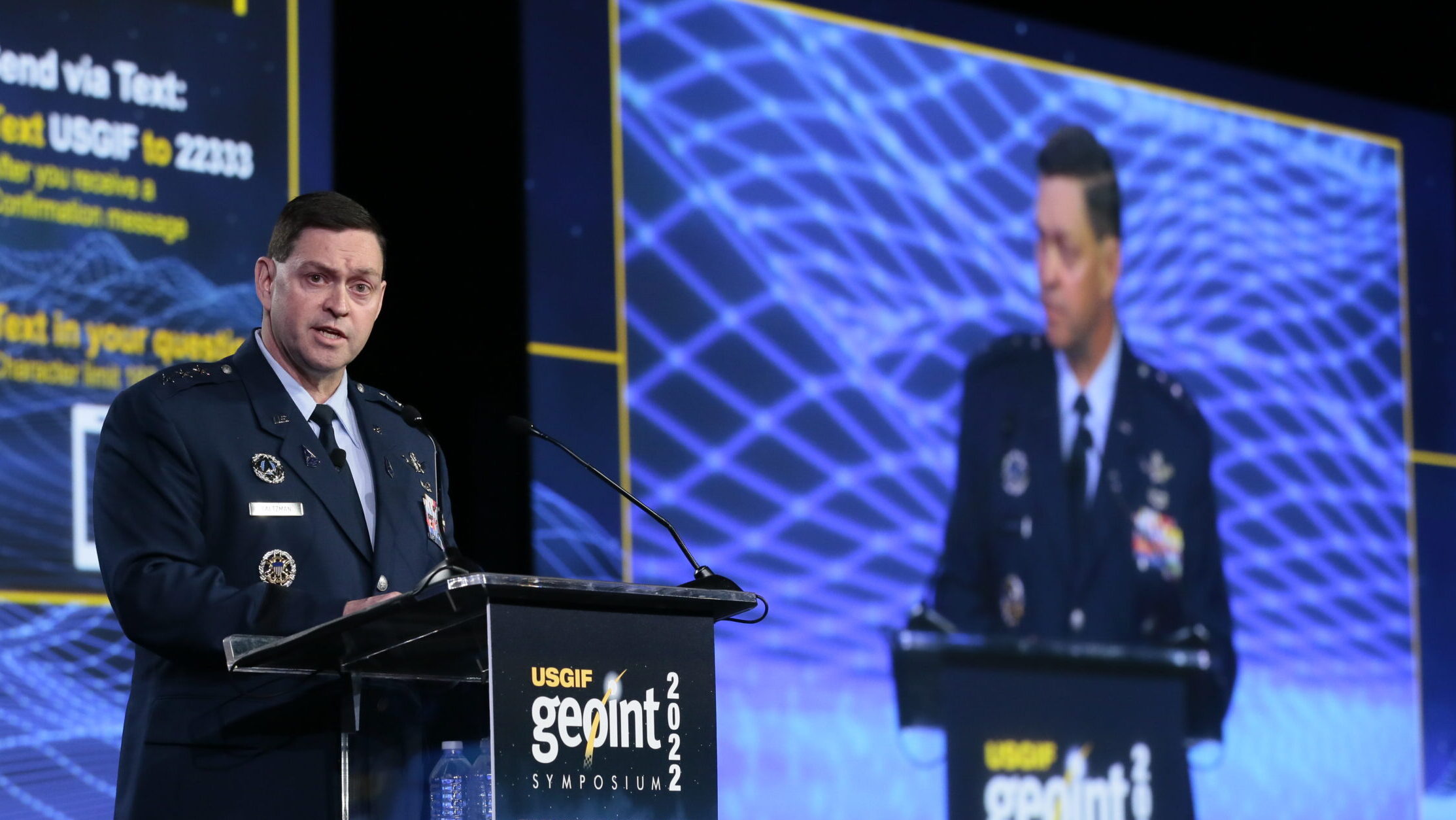
Lt. Gen. Chance Saltzman, Space Force deputy chief of space operations, cyber and nuclear, address the GEOINT 2022 conference. (Courtesy GEOINT)
WASHINGTON: The Space Force is still working with the Pentagon to establish service components to be embedded with theater combatant commands — sorting through budgetary and people-power issues, as well as the gritty administrative details that come with stationing personnel overseas, a senior Space Force official said Thursday.
The current plan is to first standup a Space Force component in Indo-Pacific Command, because of “China being the pacing threat,” Lt. Gen. Chance Saltzman, deputy chief of space operations for operations, cyber and nuclear, told the Defense Writers Group. Central Command is next on the agenda, and then European Command.
But, he said, the formal creation of those commands remains “pre-decisional,” awaiting decisions by the Secretary of Defense Lloyd Austin and his staff.
“This is a secretary of defense decision. And those decisions are not made lightly,” said Saltzman, whose call sign is (predictably) “Salty.”
“We’ve got to make sure we understand exactly what the implications are, the second, third order effects. Do we have the manpower to support? What’s the resourcing and budget?” he explained. “We have to align all that up, because we don’t want to go so fast that we hang this organization out, and it can’t be effective when it’s put in place. So, we’re really just trying to make sure we do the deliberate planning to make sure it’s successful from day one, because it’s so critical.”
Further, he noted that for theater commands headquartered overseas, establishing new military units involves working with regional allies, host countries and the State Department — and all those things “take time.”
Air Force Secretary Frank Kendall last fall signed off on the Space Force plan to establish the component commands, which are responsible for responding to operational combatant commanders’ requests for forces to handle daily missions, including exercises and war-planning. Service component officials also have an administrative function, responsible for taking care of Space Force Guardians assigned to far-flung theaters.
And until that is done, deployed Guardians are technically assigned to resident Air Force components. Changing that is essential to ensuring space power is integrated into combatant command planning, exercises and operations, Saltzman explained.
“We just think space is so critical now that we need a seat at that table, so the combat commander has a subordinate commander that they can direct to be responsible for operational level integration of all those capabilities,” he said.
For the moment, Space Operations Command assigned to Space Command is the only extant Space Force component command, established in October 2020. (To clarify for those not versed in US military organization, Space Force is a military service with the mission to organize, train and equip forces. Said forces are then assigned to operational combatant commands, of which SPACECOM is one of 11.)
And even there, Saltzman said, the Space Force is still in the thicket of dotting i’s and crossing t’s.
“That’s a huge chunk of what we do, we put a lot of effort there. And we’re still trying to figure out the exact organizational relationships and how everything works,” he said. “These are all works in progress.”
As Breaking Defense first reported, the relationship between Space Force and SPACECOM is complicated, with the lines of authority and responsibility sometimes sliding into gray. This is because the US military has never in its history had both a combatant command and a military service both dedicated to the same single mission area.
Eventually, Saltzman added, the Space Force will have to move ahead to establish a component within Cyber Command as well. CYBERCOM, unlike the other commands in line for service components, is a functional command rather than a geographic command (although arguably SPACECOM is a hybrid of both types).
Functional commands provide operations for specific missions; i.e. Transportation Command provides ground, sea and air logistics and transport support. Geographic commands have “areas of responsibility,” or AORs, that map to a region; i.e., SPACECOM’s AOR starts at 100 kilometers in altitude and extends, in theory, the end of the universe (if there is one).
“Right now, we leverage the Air Force’s component to US Cyber Command as our conduit into what our requirements, what are our issues, etc. So, we don’t have our own cyber component yet in US Cyber Command,” Saltzman explained. “I think that day will come; quite frankly, it’s too important. The service will have too many cyber responsibilities. We’re just not there yet.”
HASC chair backs Air Force plan on space Guard units (Exclusive)
House Armed Services Chairman Mike Rogers tells Breaking Defense that Guard advocates should not “waste their time” lobbying against the move.



























